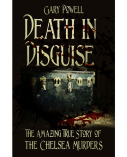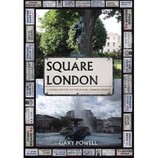Excerpts from "Square London" by Gary Powell
Introduction
If the financial City of London is her heart and the parks her lungs, then London's squares must be her soul. The London square - although based on the Italian piazza - is quintessentially English. Residential or Commercial, historical or architecturally groundbreaking, the square is one of the capital's most familiar and loved features. London's parks are enjoyed by the visitor, but its squares, they are treasured by the Londoner.
Many of London's famous and iconic features have been the subject of an author's pen. The capital's statues, parks, gardens, transport systems, galleries and museums, churches and cathedrals, blue plaques, policing and civil distrubances, cemeteries, let alone its people, all have featured in varied publications. There have been many fine accounts of individual squares such as Jean Hood's wonderful Trafalgar Square a History of a London Landmark through Time (Chrysalis Books 2005). Other books have concentrated on squares in a particular London region or borough, but it has been over one hundred years since the prolific writer of London life, Edwin Beresford Chancellor, published his History of Squares of London (1907) in which he examined some of London's most notable Squares.
This book endeavours to investigate the history of the London square, from its oldest - Covent Garden and Bloomsbury, to its most recent - Canada and Highbury. The focus is not on architectural value or style - other publications such as Pevsner's The Buildings of England series cover these areas in detail and with great authority; but on the life of the square, its occupants past and present, significant events of national importance and the dark secrets of individual buildings and their tenants.
For many years the squares of London have been neglected, resulting in a worrying level of decay. The London Squares Preservation Act of 1931 went some way to saving many of London's finest squares from the hands of future developers; but for decades the landlords of these protected squares lacked the vision, the will and he necessary funding to maintain them. In the past decade fantastic work carried out by English Heritage in partnership with many local authorities and funding from the Heritage Lottery fund have transformed many of these squares; Russell, Brunswick and Bloomsbury Squares have benefited, to name but a few, restored to a level that every Londoner can be proud of and enjoy.
Each square featured in this book has its own unique story, whether through buildings which still exist or have sadly disappeared, characters both past and present or events of tremendous public joy or deep shock and horror. What becomes apparent is the significant role the London square has played in the history of this great nation.
G.Powell
February 2012
Clapton Square E5
London Borough: Hackney
The murder of Thomas Briggs
Several years before the arrival of Rothstein at No.6 the neighbouring house No.5 was occupied by a sixty-nine year old senior bank clerk - Thomas Briggs. Briggs has the unenviable claim of being the first person to be murdered on Britain's railways. Briggs left his niece Caroline Buchan's home in Peckham, South London on the evening of 9th July 1864 with the intention of returning home to Clapton Square. He later boarded a train at Fenchurch Street Station to complete the last leg of his journey. On the train's arrival at Hackney Wick the first class carriage, in which the unfortunate Briggs had been travelling, was found empty and blood-splattered by two bank clerks who raised the alarm. Briggs was later found over a mile away lying unconscious trackside near Bow and later died. He had been struck over the head several times with a blunt instrument. The police traced the murderer, a German tailor called Franz Muller, from a hat he left at the scene. The motive for the murder appeared to be robbery as Briggs's gold watch and chain were missing. Muller by this time had boarded a ship bound for New York, but detectives caught a faster steamship and apprehended Muller on his arrival; on his arrest he was found to be in possession of Mr Briggs's watch and hat. The case highlighted the dangers of travelling on Victorian railways during the 1860's, there was no communication with the driver or guard or indeed any other carriage - it wasn't until the 1890's that communication cords were introduced on the railways. Muller was convicted at his trial and publicly executed in November of the same year in front of an estimated 50,000 people. Public executions were outlawed in 1866.
Fassett Square E8
London Borough: Hackney
Fassett Square's claim to fame
Fassett Square's claim to fame is being the prototype for Albert Square in the BBC's soap opera Eastenders; at one stage the producers intended to film in the actual square but the existence of the German Hospital annexe caused the scriptwriters problems. Local residents must have been over-joyed when the square was overlooked as the soap's permanent home - can you imagine living amongst murder, arson, robbery, domestic violence, rampaging dogs and a demented red-head screaming 'Ricckki' every five minutes?
Book
Death Diary: A Year of London Murder, Execution, Terrorism and Treason available at Amazon here.
See a list of upcoming book events.
London Walks
My upcoming London Walks.





